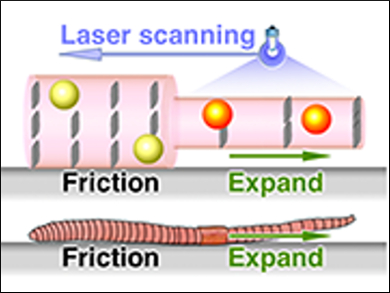Earthworms move in narrow spaces by the expansion and contraction of their body segments. This mechanism of movement, so-called peristaltic crawling, is the inspiration for soft robots, e.g., in locomotive endoscopes used for next-generation diagnosis and therapies. Water-rich hydrogels have some resemblance to biotissues and are, thus, a promising material with which to construct such soft robots.
Takuzo Aida, University of Tokyo and RIKEN Center for Emergent Matter Science, Wako, Saitama, both Japan, Yasuhiro Ishida, RIKEN Center for Emergent Matter Science, and colleagues have developed an unprecedented type of photoresponsive hydrogel actuator. The hydrogel contains gold nanoparticles that convert photon energy into heat, a thermoresponsive polymer composed of N-isopropylacrylamide monomers and N,N‘-methylenebisacrylamide crosslinkers that switches the electrical permittivity of the gel’s interior, and charged titanate nanosheets that change the electrostatic repulsion of the hydrogel simultaneously.
When irradiated with light, the hydrogel expands within half a second and lengthens by 180 %. The cylinder crawls like an earthworm when it is irradiated along its long axis with a 445 nm laser spotlight. The researchers believe that this technology could make soft robotics a reality in the future.
- An Anisotropic Hydrogel Actuator Enabling Earthworm-Like Directed Peristaltic Crawling,
Zhifang Sun, Yoshihiro Yamauchi, Fumito Araoka, Youn Soo Kim, Julian Bergueiro, Yasuhiro Ishida, Yasuo Ebina, Takayoshi Sasaki, Takaaki Hikima, Takuzo Aida,
Angew. Chem. Int. Ed. 2018, 57, 15772–15776.
https://doi.org/10.1002/anie.201810052


